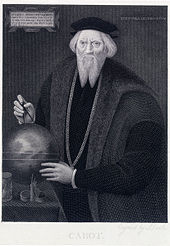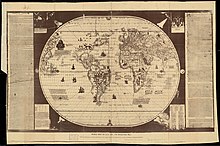Sebastiano Caboto
Sebastiano Caboto ( English Sebastian Cabot , Spanish Sebastián Gaboto ; * 1484 at the latest in Venice , † 1557 in London ) was a discoverer and cartographer from Venice who was in the service of the English and Spanish crowns. Today he is best known for the world map printed on his behalf, of which a copy from 1544 has survived.
Life
Childhood and youth
Caboto's father was the navigator Giovanni Caboto . From his marriage to the Venetian Mattea in 1482, his brothers Ludovico and Sancio were born in addition to Sebastiano. Sebastian's exact year of birth is not known, but it is certain that he and his older brother Ludovico were born in 1484. From Caboto's later information about his age, it can be concluded that he was born this year or just a few years earlier.
During his childhood he came to England with his father at the end of 1495. It is possible that he accompanied him on his two famous expeditions off the coast of North America in 1497 and 1498, but this could not be clarified beyond doubt. While Sebastian's participation in the first expedition is claimed on his world map from 1544, there is no evidence of participation in the second. Nonetheless, from 1505 onwards he received an annual payment from Henry VIII for the discovery of the "new founde land". However, he could also have received this solely in recognition of the merits of his - now deceased - father.
In any case, Sebastiano Caboto himself supported this assumption as much as he could, according to a chronicler he is even said to have claimed that his father died before the first trip. This led to the prevailing belief into the 19th century that it was not his father but Sebastian who undertook the expeditions.
Suspected expedition to Hudson Bay
No travel reports written by him have come down to us from Caboto's expeditions. It is believed that he led an expedition off the coast of North America in 1508 and 1509, reports of which exist by Petrus Martyr and Giovan Battista Ramusio , who rely on Caboto as an informant. According to these, Caboto had entered arctic waters in search of the Northwest Passage . At 67 ° 30'N he was urged by his team to turn back off the coast of the Labrador Peninsula . Between 61 ° and 64 ° N, he discovered a wide strait of the sea, into which he sailed up to 10 degrees of longitude, where a wide area of the sea opened up - according to Caboto's view, the Pacific Ocean . As far as one can believe this information, it was about Hudson Bay .
On behalf of the Spanish
Caboto no longer carried out an expedition for the English king. In May 1512 he went to Spain in tow with the English army planning an invasion of France . There he joined the Spanish Crown as captain in October 1512. He was likely to lead another expedition in 1516, but it never took place. Instead, he received the post of leading navigator in the Casa de Contratación in February 1518 . As such, his task was to teach navigation methods and the production of appropriate instruments, to train navigators, and to correct and improve the available map material. He was also the king's geographic advisor on overseas navigation.
In 1524 the planning of an expedition began, of which Caboto was appointed. This actually had the goal of finding a way to India on a south-easterly course, but in the course of the planning an exploration of the South American coast was increasingly brought to the fore. On April 3, 1526, Caboto set sail with four ships and a crew of 200 from Sanlúcar de Barrameda . After the Canary Islands and the Cape Verde Islands , Caboto, contrary to the advice of his navigators, took a south-south-west course, whereby the ships got into a windless region and could only go ashore after more than a month north of Pernambuco . Along the coast one reached Cabo Frio three months later , and after another month the island of Santa Catarina , where a ship, the Capitana , ran aground on October 28th and had to be abandoned. Caboto now decided to explore the region around the Río de la Plata , as he hoped, based on reports from Spanish settlers, to find mineral resources there. Several officers who opposed Caboto's change of plan were abandoned on Santa Catarina. In February 1527 the ships sailed into the mouth of the Río de la Plata. In August, a fortress called San Salvador was built at the confluence of the Río Uruguay with the Río San Salvador , for which the wood of two ships was used. With the remaining brigantine and a galley built on Santa Catarina , Caboto continued his search for gold, first along the Río Carcarañá , and later following the Río Paraguay . After 18 of his men were killed in a raid by Indians, he turned back and wintered in Fort San Salvador . Meanwhile, he sent a ship back to Spain to report on the voyage so far and to bring fresh supplies. In the spring of 1529 he went upriver again and reached Sancti Spiritu , which, however, was sacked by the Indians in October 1529 in his brief absence. Caboto returned with the heavy cannons to San Salvador , where on October 6, 1529 it was decided to return to Spain. With 50 Indians captured as slaves, he reached Seville on July 22, 1530 with a ship and a crew of only 24 .
Soon after his return, Caboto was charged by both the Spanish crown and the relatives of the suspended officers for disobeying orders and the negligent homicide of subordinates, and in July 1531 he was sentenced to two years' exile in Africa and heavy damages. In an appeal in February 1532, the exile was increased to four years. In the meantime, however, the Spanish King Charles V had returned from a stay in Germany , and at an audience in the spring of 1532 Caboto told him about the results of the trip. Although there is no record of a pardon, Caboto never had to begin his exile. Instead, he got his post as navigator in the Casa de Contratación back.
In March 1541 he commissioned two printers from Germany, "Lazaro Noremberguer" (also "Lazaro Aleman" or "Lazaro Cromberger") and "Gabriel Miçel" to print a world map; In 1545 he seems to have placed another order. A copy of these maps is now in the possession of the Paris Bibliothèque nationale and is the only surviving map material from Caboto.
In the following years, Caboto worked on the revision of the Padrón Real , the most important world map kept secret in the possession of the Spanish crown, which served as a template for all maps on Spanish ships in the 16th century. He often got into disputes with other cartographers about this. In 1544 he supported an amendment by the Padrón Real by Diego Gutiérrez , which called for a finer division of the longitudes of the map. Caboto made reports of related errors in the Padrón, but was overruled by other cartographers and had to agree to the official rejection of Gutiérrez Reform in 1545.
Return to England and death
As early as the end of the 1530s, Caboto seems to have been dissatisfied with his employment in Spain, so he applied unsuccessfully for a job in England in 1538. After Henry VIII's death , the Privy Council issued him a £ 100 certificate to return to England in October 1547. In 1548 Caboto returned to England. In the following years the Spanish king repeatedly asked him to return to Spain, but Caboto never complied.
In England, Caboto dealt with the Northeast Passage . He became governor of the Muscovy Company, founded in the spring of 1553 . From March 1557 Caboto received pension payments, at the latest in December of the same year he died.
Familiar
Caboto was married with children when he entered the service of the Spanish Crown in 1512. A document dated September 1514 mentions that his wife Juana, who came from London , has since died. In Spain he married again, in August 1525 Catalina de Medrano is named as his wife. Catalina de Medrano died on September 2, 1547. In 1533 a daughter died. An English document from 1586 mentions Henry Ostryge, who accompanied Caboto to England in 1548 and was his son-in-law.
Literature and web links
- RA Skelton : Cabot, Sebastian . In: Dictionary of Canadian Biography . tape 1: 1000-1700 . University of Toronto Press, Toronto 1979, ISBN 0-8020-3142-0 ( English , French ).
- William James Mills: Exploring Polar Frontiers: A Historical Encyclopedia. ABC-CLIO, Santa Barbara 2003, ISBN 1-57607-423-4 , p. 124 f.
- Piero Falchetta: Carte geografiche e cartografi a Venezia al tempo di Giovanni Caboto, lecture at the International Conference "Attraversare l'oceano - Crossing the Ocean". Toronto, 1997, English: Maps and Mapmakers in Venice in Cabot's Time. Volume: Attraversare gli oceani. Da Giovanni Caboto al Canada multiculturale , ed. by Rosella Mamoli Zorzi, Venice 1999, pp. 73-82.
- José de Acosta : The gold of the condor. Reports from the New World 1590 and atlas on the history of its discovery. Edited and transmitted by Rudolf Kroboth and Peter H. Meurer . Edition Erdmann in K. Thienemanns Verlag, Stuttgart et al. 1991, ISBN 3-522-60750-3 (Original edition: America, Or how mans to Teutsch calls Die Neuwe Welt / or West India. By Mr. Josepho De Acosta in seven books / one part in Latin / and partly in Hispanic / Described. Sutorius, Ursel 1605). After the copy in the State Library of Prussian Cultural Heritage, Berlin.
Web links
- Literature by and about Sebastiano Caboto in the catalog of the German National Library
Remarks
- ↑ Hans-Jürgen Hübner: Giovanni Caboto or John Cabot. www.geschichte-venedigs.de, accessed on July 10, 2013 .
- ↑ a b c d e f g h i j k l Dictionary of Canadian Biography.
- ↑ Alwyn Ruddock: The reputation of Sebastian Cabot. From: Bulletin of the Institute for Historical Research. Volume 47, 115th edition, May 1974.
- ↑ a b c Wills (2003)
| personal data | |
|---|---|
| SURNAME | Caboto, Sebastiano |
| ALTERNATIVE NAMES | Cabot, Sebastian; Gaboto, Sebastián; Cabot, Sebastien |
| BRIEF DESCRIPTION | Italian explorer |
| DATE OF BIRTH | before 1484 |
| PLACE OF BIRTH | Venice |
| DATE OF DEATH | 1557 |
| Place of death | London |

